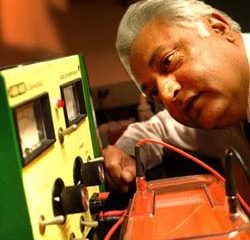
A biomedical-imaging technique that would highlight the cytoskeletal infrastructure of nerve cells and map the nervous system as it develops and struggles to repair itself has been proposed by biophysics researchers at Cornell and Harvard universities.
Reporting in Proceedings of the National Academy of Sciences (PNAS June 10, 2003) , the researchers say that besides the new imaging technique’s obvious applications in studying the dynamics of nervous system development, it could answer the

The tiny spheres inside brain cells that ferry chemical messengers into the synapse make their rounds much more expeditiously than once assumed, National Institute of Mental Health (NIMH) – funded researchers have discovered. They used a dye to track the behavior of such synaptic vesicles in real time, in rat brain cells. Rather than fusing completely with the cell membrane and disgorging their dye contents all at once, brain vesicles more often remained intact, secreting only part of the tracer car

C.J. Zhong hopes that within the next three to five years diabetics the world could see their quality of life enhanced by his tiny invention-a chip-sized pump with no moving parts. The device is also expected to find its way into myriad industrial and environmental applications, where it could mean huge savings in manufacturing and monitoring processes.
Zhong’s patent on the low-power, electrically driven pumping device is one of the reasons the State University of New York has broken i

Inflation’s got nothing to do with it. Since the beginning of time, a picture has always been worth more than a thousand words. But in this age of information proliferation, that reality is the taproot of a vexing problem that Zhongfei “Mark” Zhang, an assistant professor of computer science at Binghamton University, is determined to help solve.
From personal and commercial digital image libraries and multimedia databases to data mining programs and high-tech security and defense survei

The answer to how the complex, cavernous inner ear forms from a mostly homogenous group of cells may be that it doesn’t, says a Medical College of Georgia researcher who has found a new cell type that appears to migrate to the developing ear.
Dr. Paul Sohal first saw the cells he named ventrally emigrating neural tube cells in 1995, following the path of newly formed nerves out of the developing neural tube.
His research published in the June issue of the International Journal of D

Researchers will assess how businesses manage waste
Researchers at Cardiff University, UK, are aiming to gather vital information from a load of garbage.
Businesses and commercial organisations in Wales, UK, generate millions of tonnes of waste each year, and much of it goes to landfill sites – a method of disposal which is causing mounting environmental concern and is increasingly subject to legislation.
Yet current data on how much waste is produced, what it comp

At the Berlin synchrotron radiation source BESSY II, the largest magnetic anisotropy of a single molecule ever measured experimentally has been determined. The larger this anisotropy is, the better a…

LSU quantum researchers uncover hidden quantum behaviors within classical light, which could make quantum technologies robust. Understanding the boundary between classical and quantum physics has long been a central question…

One of the biggest mysteries in science – dark energy – doesn’t actually exist, according to researchers looking to solve the riddle of how the Universe is expanding. For the…

A team led by plant biotechnologist Prof Markus Schwarzländer from the University of Münster and biochemist Prof Bruce Morgan from Saarland University has developed new biosensors with which the ratio…

How deubiquitinases USP53 and USP54 cleave long polyubiquitin chains and how the former is linked to liver disease in children. Deubiquitinases (DUBs) are enzymes used by cells to trim protein…

Conceptual blueprint to analyze experimental catalyst data. Machine learning (ML) models have recently become popular in the field of heterogeneous catalyst design. The inherent complexity of the interactions between catalyst…

How simulations help manufacturing of modern displays. Modern materials must be recyclable and sustainable. Consumer electronics is no exception, with organic light-emitting diodes (OLEDs) taking over modern televisions and portable…

“Neurons that fire together, wire together” describes the neural plasticity seen in human brains, but neurons grown in a dish don’t seem to follow these rules. Neurons that are cultured…

The quest for sustainable energy solutions has been a major focus of scientific research for decades. Solar energy, a clean and renewable source, has emerged as a promising alternative to…

Pacific Northwest National Laboratory to contribute leadership to national effort in microelectronics design and development. Microelectronics run the modern world. Staying ahead of the development curve requires an investment that…

With a processing speed a billion times faster than nature, chip-based laser neuron could help advance AI tasks such as pattern recognition and sequence prediction. Researchers have developed a laser-based…

New technology could remotely identify various types of plastics, offering a valuable tool for future monitoring and analysis of oceanic plastic pollution. Researchers have developed a new hyperspectral Raman imaging…